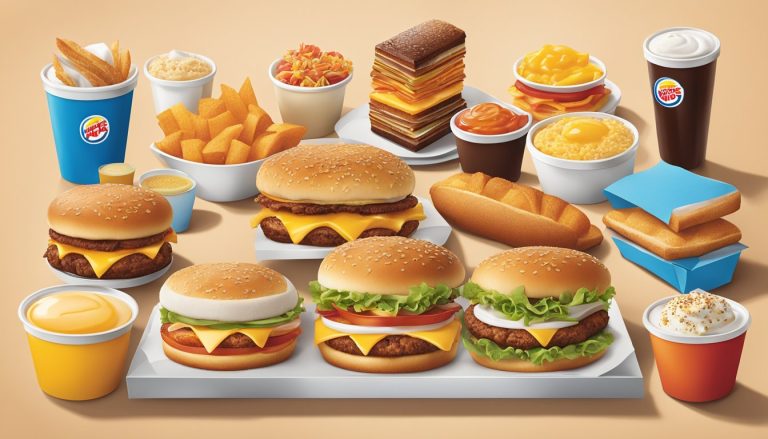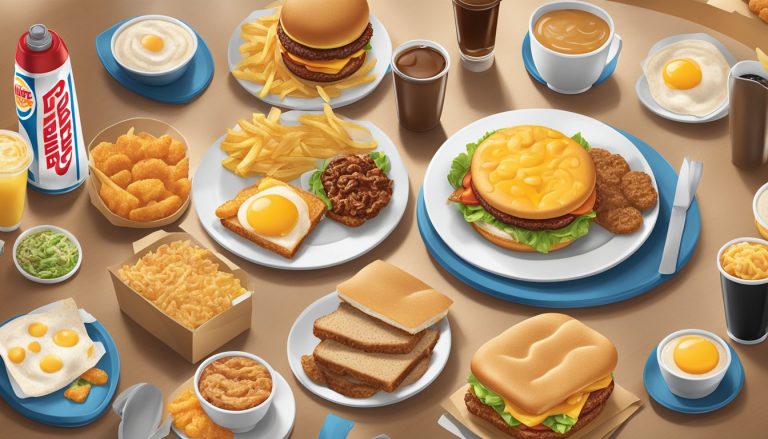Burger King’s breakfast menu has been a staple for early risers since its introduction. The fast-food giant serves up a variety of morning options from 6:00 AM to 10:30 AM on weekdays and Saturdays, with an extended 11:00 AM end time on Sundays. Portion sizes at Burger King have evolved over the years, reflecting changing consumer preferences and nutritional awareness.
The breakfast lineup includes classics like the Croissan’wich, Egg-Normous Burrito, and crispy Hash Browns. These items have maintained their popularity while adapting to modern tastes. Burger King offers a range of portion sizes to cater to different appetites, from lighter fare to heartier platters.
As customer demands shift, Burger King continues to adjust its breakfast offerings. The chain balances tradition with innovation, ensuring that long-time favorites remain available alongside new, exciting options. This approach allows Burger King to maintain its position as a go-to destination for breakfast on-the-go.
History of Burger King’s Breakfast
Burger King’s breakfast journey began in the late 1970s, marking a significant expansion of their menu offerings. The fast food chain’s morning selections have undergone numerous changes and innovations over the decades.
Origin of BK Breakfast
Burger King introduced its breakfast menu in 1979, entering the morning meal market after competitors like McDonald’s. The initial offerings were limited, aiming to capture the growing demand for convenient breakfast options. BK’s breakfast debut included simple items like breakfast sandwiches and platters.
The move was strategic, responding to changing consumer habits and the increasing popularity of eating breakfast on-the-go. Burger King’s breakfast items quickly gained traction among customers seeking quick, tasty morning meals.
Evolution of Breakfast Items
Throughout the 1980s and 1990s, Burger King expanded its breakfast menu. The chain introduced new items and improved existing ones to stay competitive. In 1983, BK launched the Croissan’wich, a croissant-based sandwich that became a breakfast staple.
The breakfast platters evolved to include more diverse options, catering to varying customer preferences. BK also experimented with regional specialties and limited-time offers to keep the menu fresh and exciting.
Healthier options were gradually added to the menu, reflecting changing consumer attitudes towards nutrition. These included fruit cups, oatmeal, and lighter sandwich alternatives.
Introduction of Key Breakfast Products
Burger King’s breakfast menu saw several key product launches over the years. The French Toast Sticks, introduced in 1986, became an instant hit and remain popular today. These sweet, dippable treats offered a unique alternative to traditional breakfast fare.
In the early 2000s, BK introduced the Enormous Omelet Sandwich, targeting hungry customers with its substantial size. This bold move showcased the chain’s willingness to push boundaries in portion sizes.
More recent additions include the Breakfast Burrito and various coffee drinks, as Burger King aimed to compete with coffee shop chains. These introductions helped BK maintain relevance in the ever-evolving breakfast market.
Comparative Analysis of Portion Sizes

Breakfast portion sizes at Burger King have undergone significant changes over the years. These shifts reflect evolving consumer preferences and industry trends.
Historical Portion Sizes
In the 1970s and 1980s, breakfast portions at Burger King were notably smaller. A typical breakfast platter contained 2-3 pancakes, 1 sausage patty, and a small serving of hash browns. French Toast Sticks came in a 3-piece serving. The calorie count for most breakfast items ranged from 300-400 calories.
Protein content was moderate, with options like eggs and sausage providing 10-15 grams per serving. Hash browns were often a small patty, about 2 ounces in weight.
Current Portion Sizes
Today’s breakfast portions at Burger King are substantially larger. The breakfast platter now includes 3-4 pancakes, 2 sausage patties, and a larger serving of hash browns. French Toast Sticks are available in 5-piece servings.
Calorie counts have increased, with many breakfast items now ranging from 500-700 calories. Protein content has also risen, with some options providing 20-25 grams per serving.
Hash browns are now available as a larger, 4-ounce portion. The increase in portion sizes aligns with industry trends observed since the 1990s.
Consumer Perception on Portion Changes
Many consumers have adapted to these larger portions, often perceiving them as standard. A study found that typical portion sizes selected by young adults were significantly larger than reference portions.
This “portion distortion” has led to a disconnect between recommended serving sizes and what consumers consider normal. For example, consumers may now view a 5-piece serving of French Toast Sticks as typical, despite it being larger than historical norms.
The perception of value has also shifted, with many customers expecting larger portions for their money. This expectation has influenced menu design and portion sizing across the fast-food industry.
Nutritional Information
BK’s breakfast menu offers a range of options with varying nutritional profiles. Caloric content, protein levels, and industry comparisons provide insights into the dietary impact of these morning choices.
Caloric Content of Breakfast Items
The BK Ultimate Breakfast Platter stands out as one of the most calorie-dense options, containing 1190 calories. This hefty meal accounts for over half of the average adult’s daily caloric needs.
Breakfast sandwiches offer a more moderate calorie range. The Bacon, Egg & Cheese Biscuit, for example, contains around 460 calories.
For those seeking lighter fare, the Egg-Normous Burrito provides a substantial meal at approximately 710 calories.
Protein Levels in Breakfast Options
Protein content varies significantly across BK’s breakfast menu. The Egg-Normous Burrito leads in protein, offering about 32 grams per serving.
Breakfast sandwiches typically contain 15-20 grams of protein, making them a solid choice for morning fuel.
The Pancake Platter, while lower in protein, still provides about 10 grams, primarily from the accompanying eggs and sausage.
Comparison with Industry Standards
BK’s breakfast offerings generally align with industry standards for fast-food morning meals. Calorie counts are comparable to those of major competitors.
Protein levels in BK’s breakfast items meet or exceed industry averages, particularly in options featuring eggs and meats.
Sodium content is an area of concern, with many items containing over 1000mg, which is high compared to dietary recommendations.
Fat content varies widely, from moderate levels in simple sandwiches to higher amounts in platters and burritos.
Core Breakfast Offerings

Burger King’s breakfast menu features a diverse range of options to satisfy various appetites. The core offerings include popular sandwiches, hearty platters, and vegetarian choices.
Signature Breakfast Sandwiches
The Croissan’Wich stands out as Burger King’s flagship breakfast sandwich. It combines a flaky croissant with eggs, cheese, and a choice of meat. Sausage, bacon, and ham options cater to different tastes.
The Sausage Biscuit offers a Southern-inspired alternative. Its buttermilk biscuit provides a satisfying base for savory sausage patties.
For those seeking a lighter option, Burger King also serves breakfast sandwiches on English muffins. These feature similar ingredient combinations to the Croissan’Wich but with fewer calories.
Platters and Burritos
Burger King’s breakfast platters cater to hearty appetites. The pancake platter includes fluffy pancakes, eggs, and a choice of meat. Hash browns often accompany these meals as a crispy side.
The Egg-Normous Burrito packs a substantial breakfast into a portable format. It contains eggs, cheese, hash browns, and meat wrapped in a warm tortilla. This option appeals to customers looking for a filling meal on-the-go.
French Toast Sticks offer a sweet alternative. These golden-brown strips come with syrup for dipping, making them a popular choice among both adults and children.
Vegetarian Alternatives
Burger King has expanded its menu to include vegetarian-friendly options. The Impossible Croissan’Wich features a plant-based sausage patty made by Impossible Foods. This sandwich mimics the taste and texture of meat while remaining meat-free.
Meat-free alternatives also include egg and cheese sandwiches on various bread options. These provide protein without animal products.
For those seeking lighter fare, oatmeal and fruit options may be available at some locations. These choices cater to health-conscious customers looking for lower-calorie breakfast items.
Menu Innovation and Promotions

Burger King’s breakfast menu has evolved through creative offerings and strategic marketing. The chain regularly introduces new items and runs promotional campaigns to attract customers during morning hours.
Limited Time Offers
BK frequently launches limited-time breakfast items to generate buzz and drive sales. The Impossible Croissan’wich, introduced in 2020, features a plant-based sausage patty. This innovative option caters to vegetarian and flexitarian diners.
Other temporary additions have included the Maple Waffle Sandwich and the French Toast Sandwich. These unique creations combine familiar breakfast flavors in novel ways, enticing customers to try something new.
BK also experiments with breakfast-inspired twists on classic menu items. The Breakfast Whopper, available for a short period, topped the iconic burger with egg and hash browns.
Seasonal Variations
Burger King adapts its breakfast menu to reflect seasonal tastes and holidays. During fall, they may offer pumpkin spice variations of coffee drinks or breakfast pastries.
Winter promotions often feature warm, comforting dishes like cinnamon rolls or hot chocolate. Spring and summer see lighter options, such as fruit smoothies or yogurt parfaits added to the menu.
These seasonal items create a sense of urgency and encourage repeat visits from customers eager to try limited-edition flavors before they disappear.
Marketing Campaigns and Promotions
BK employs various marketing tactics to promote its breakfast offerings. Value-focused deals, like 2 for $4 mix-and-match breakfast sandwiches, appeal to budget-conscious consumers.
The BK Café line of coffee drinks receives dedicated advertising to compete with coffee shop chains. Promotions often include discounted or free coffee with breakfast purchase.
Social media campaigns highlight new menu items and share customer experiences. BK leverages influencer partnerships and user-generated content to build buzz around breakfast innovations.
Loyalty program rewards specifically target breakfast purchases, incentivizing customers to choose BK for their morning meal. These promotions aim to build habitual breakfast visits and increase customer retention.
Breakfast Service
Burger King’s breakfast service offers a range of options during specific morning hours. The chain prioritizes efficient operations and a positive customer experience.
Operational Breakfast Hours
Burger King serves breakfast from 6:00 AM to 10:30 AM on weekdays. Weekend hours may extend to 11:00 AM at some locations. This consistent schedule allows customers to plan their morning meals reliably.
Some 24-hour Burger King restaurants may start breakfast service earlier. The transition from breakfast to the regular menu occurs promptly at the end of breakfast hours.
Process Efficiency and Customer Experience
Burger King aims for quick service during busy breakfast rushes. Staff are trained to handle morning-specific menu items efficiently.
The breakfast menu includes popular combos like the Croissan’wich and Egg-Normous Burrito. These are often paired with hash browns and coffee.
Coffee options typically include regular and decaf brews. Some locations may offer specialty coffee drinks.
Breakfast sides like hash browns and french toast sticks complement main dishes. These items are prepared fresh throughout the morning.
Burger King’s breakfast service balances variety with speed to meet customer needs during peak morning hours.
Beverage Options

Burger King offers a range of coffee and beverage choices to complement their breakfast menu. These options cater to different tastes and preferences, from classic brews to flavored varieties.
Traditional Coffee Selections
BK Café provides customers with a selection of hot coffee options. The standard drip coffee is available in small, medium, and large sizes. For those who prefer a stronger taste, Burger King offers a dark roast option.
Decaf coffee is also on the menu for customers seeking a caffeine-free alternative. Hot tea is available for non-coffee drinkers. Cream, sugar, and artificial sweeteners are provided at self-serve stations.
Iced and Flavored Coffee Varieties
Burger King has expanded its beverage lineup to include iced coffee options. The classic iced coffee comes in various sizes and can be customized with cream and sugar.
Flavored iced coffees are popular choices. Vanilla, mocha, and caramel flavors are typically available. These drinks can be ordered with or without whipped cream topping.
For a more indulgent treat, BK offers frappes in flavors like mocha and caramel. These blended ice drinks combine coffee with milk and flavored syrups for a dessert-like experience.
Seasonal flavored coffees, both hot and iced, are sometimes introduced for limited periods. These may include pumpkin spice in fall or peppermint during winter months.
Consumer Trends and Preferences
Breakfast habits have evolved significantly in recent years, with health-consciousness and convenience playing major roles. Consumers are actively seeking nutritious options while balancing busy lifestyles.
Health Conscious Choices
Diners increasingly prioritize nutritional value in their breakfast selections. Low-calorie and high-protein options have gained popularity. Many opt for egg white omelets or Greek yogurt parfaits to start their day. Oatmeal, particularly varieties like maple flavor oatmeal, has seen a resurgence due to its health benefits and customizable nature.
Calorie counts are now prominently displayed on menus, influencing consumer decisions. Plant-based alternatives such as almond milk and veggie sausages have become mainstream choices. Restaurants have responded by expanding their healthier offerings.
Demand for Convenience
Time-pressed consumers seek quick, portable breakfast solutions. Grab-and-go items like breakfast sandwiches and wraps have experienced significant growth. Many chains now offer all-day breakfast menus to cater to varied schedules.
Mobile ordering and drive-thru options have become essential for busy customers. Meal prep trends have also influenced breakfast habits, with consumers preparing make-ahead options like overnight oats. Portion control has gained importance, with snack-sized items and mini versions of popular breakfast foods gaining traction.
Breakfast delivery services have expanded, allowing people to enjoy restaurant-quality meals at home or work. This trend accelerated during recent years and continues to shape the breakfast landscape.




